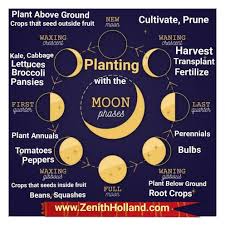Planting by the moon phase:
A few days ago, I mentioned to my friend I was planting seeds on Saturday.” Oh,” She exclaimed, “are you planting according to the moon?” I was a little taken aback as I never thought of the moon in connection to gardening and planting. I investigated further and found that most farmers and gardeners follow the moon phases for planting. I almost dismissed it as mumbo-jumbo, but it piqued my interest. So people, the planting by moon phase as a tradition has a scientific background to it. This is NOT astrological but relates to the waxing and waning of the moon. Ancient cultures followed it and so do most modern farmers. This does not really apply to hydroponics quite the same though but is an experiment worth trying.
Here is the thumb rule. Plant all your above-ground crops and flowers on new moon day, and plant all your below-ground crops and tubers on full moon day. Basically, it is to do with being in tune with nature’s rhythms. Our ancient civilizations were very much in tune with their natural surroundings. Most of these were recorded through observations and through experimentation.
And for the curious, here is the scientific explanation. Just as the moon cycles affect the tides because of the gravitational force, it affects the moisture in the soil. It is said that the seeds will absorb more moisture during the new moon and full moon as the gravitational force of the moon brings the moisture closer to the surface. This causes the seeds to swell resulting in faster germination and healthier plants. The Moon also impacts plant growth through geotropism—which is how plants grow in response to gravity. Roots grow downward in the direction of gravitational pull and stems grow in the opposite direction (i.e., upwards). This behaviour can be easily demonstrated with potted plants. Lay one on its side and the stem will grow upwards. Consider a tulip bulb, for instance, if you plant the bulb incorrectly with the pointed end down, it will turn around and send its shoots upward, even though it’s in total darkness.
So, plant your annual flowers and fruit and vegetables that bear crops above ground (such as corn, tomatoes, watermelon, and zucchini) during the waxing of the Moon—from the day the Moon is new to the day it is full. As the moonlight increases night by night, plants are encouraged to grow leaves and stems.
Plant flowering bulbs, biennial, and perennial flowers, and vegetables that bear crops below ground (such as onions, carrots, and potatoes) during the waning of the Moon—from the day after it is full to the day before it is new again. As the moonlight decreases night by night, plants are encouraged to grow roots, tubers, and bulbs.
We have a new moon today, and the weather is turning. Do plant your above-the-ground plants in the next few days. And when we have the full moon start planting your bulbs and tubers! Enjoy the start of the new gardening season in the Gulf!

Just another fun site with some interesting facts:







2 Responses
Interesting!! Thanks for sharing this topic Gardening by the Moon…
The truth is I did not know about it until I started by chance and found how amazing it is.